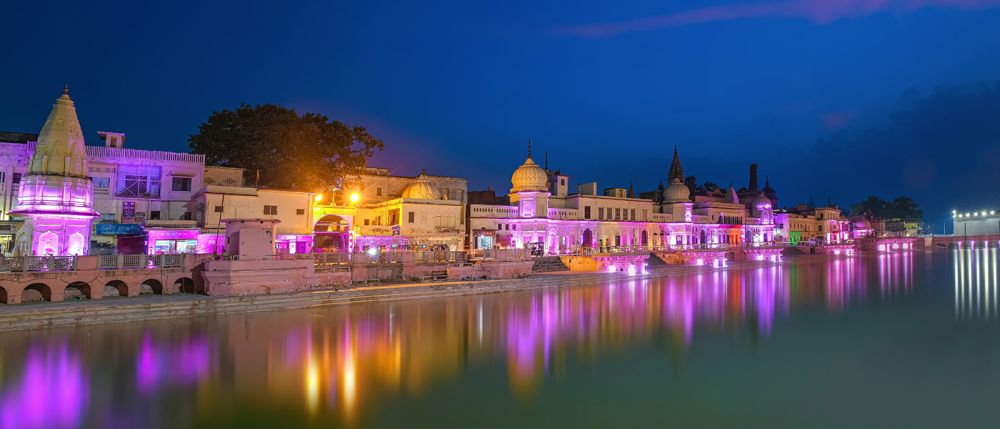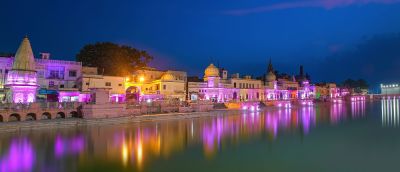

A visit to the iconic Taj Mahal in Agra is an experience no traveler should miss when in Uttar Pradesh. This ivory-white marble mausoleum, one of the seven wonders of the world, was built by Mughal Emperor Shah Jahan in memory of his beloved wife Mumtaz Mahal. The complex is an outstanding example of Mughal architecture, with beautiful gardens, reflecting pools, and intricate carvings. Visitors can marvel at the craftsmanship and learn about the history and love story behind its creation. The best times to visit are either at dawn or dusk when the crowds are smaller, and the changing light casts different hues on the marble.
Experience the spiritual heart of India with a boat ride along the Ganges in Varanasi. As one of the world's oldest continually inhabited cities, Varanasi is rich in history and religious significance. A boat ride at sunrise offers a view of life along the ghats (steps leading down to the river), with worshipers performing rituals, yogis practicing asanas, and the haunting sound of temple bells. You'll witness the beauty and the cultural vibrancy of this sacred city. The boats typically start from Dasaswamedh Ghat and cover several other significant ghats along the river.
Sarnath, located just 10 km from Varanasi, is a revered site where Lord Buddha gave his first sermon after attaining enlightenment. The site encompasses numerous Buddhist structures, including the famous Dhamek Stupa, Ashoka Pillar, and the Sarnath Museum. An archaeological tour of Sarnath can enlighten visitors about ancient Indian history, the origins of Buddhism, and the Ashokan era. The museum houses a collection of Buddhist art and sculptures, some dating back to the 3rd century BCE. This spiritual and historical exploration offers insight into the religious diversity and heritage of India.
Fatehpur Sikri, a UNESCO World Heritage Site near Agra, was once the capital of the Mughal Empire under Emperor Akbar. It is renowned for its well-preserved structures, including the Buland Darwaza, Jama Masjid, and Panch Mahal. Exploring this ghost town offers a glimpse into the life of the Mughals, their architecture, and planning. The blend of Islamic and Hindu architecture symbolizes the religious tolerance of Emperor Akbar. Although abandoned due to a lack of water, this red sandstone city remains a remarkable example of Mughal architecture.
Lucknow, the capital of Uttar Pradesh, is famed for its unique Chikankari embroidery. Spending a day exploring the bustling bazaars, such as the famous Hazratganj and Aminabad, can uncover a range of intricately embroidered garments, from sarees to kurtas. Visitors can not only buy high-quality Chikankari clothes but also learn about the delicate art form, which has been part of Lucknow's heritage for centuries. The markets also offer a range of other wares, including traditional jewelry, footwear, and scrumptious local cuisine.
Ayodhya, the birthplace of Lord Rama, is a city steeped in devotion and history. A pilgrimage tour here includes a visit to the Ram Janmabhoomi temple site, Hanuman Garhi, and the Kanak Bhawan. Pilgrims can partake in various religious ceremonies, witness the aartis, and soak in the spiritual atmosphere. The city is dotted with temples and ghats along the Sarayu River, adding to its serene ambiance. With the development of the new Ram temple, Ayodhya is undergoing transformation, but its essence remains embedded in Hindu mythology and beliefs.
Immerse yourself in the charm of Old Lucknow, with a guided walk through its historic lanes. Discover architectural gems from the Nawabi era, such as the Bara Imambara with its sprawling complex and the intricate Rumi Darwaza. The walk can lead you to culinary delights like the famous Tunday Kababi, where you can try the delectable kebabs. A blend of history, culture, and gastronomy, a stroll through Old Lucknow conveys the grandeur of bygone times and the vibrant culture of the city.
Mathura, the birthplace of Lord Krishna, and Vrindavan, where he spent his childhood, are essential stops for those seeking spiritual enrichment. The temple circuit spans both towns featuring prominent sites like the Krishna Janmasthan Temple Complex, Banke Bihari Temple, and ISKCON Temple. Visitors can experience the fervent devotion, attend the colorful aartis, and enjoy the traditional music and dance that celebrate the life of Krishna. The area is alive with folklore, hymns, and the fragrance of temple flowers, offering a divine encounter with one of Hinduism's most cherished deities.
Bordering Nepal in the Terai region of Uttar Pradesh, Dudhwa National Park is a haven for wildlife enthusiasts. The park boasts a rich diversity of fauna, including the Royal Bengal tiger, Asiatic elephant, and one-horned rhinoceros. A wildlife safari here provides the opportunity to observe these majestic creatures in their natural habitat. The park's dense sal forests, grasslands, and wetlands also support an array of birds, making it a prime spot for birdwatching. The safaris are typically conducted in jeeps, and visitors are accompanied by trained guides.
The Kumbh Mela is a mass Hindu pilgrimage of faith, held in rotation among four sacred riverside towns, including Allahabad (Prayagraj) in Uttar Pradesh. It's known as the world's largest peaceful gathering. Pilgrims come from all walks of life to bathe in the holy waters, which is believed to cleanse them of sins and aid in attaining moksha (liberation). The entire city transforms during Kumbh Mela, with numerous temporary ashrams, food stalls, and religious discourses springing up. Visitors can witness processions of sadhus, or holy men, participate in communal prayers, and experience Hinduism's profound spirituality.
